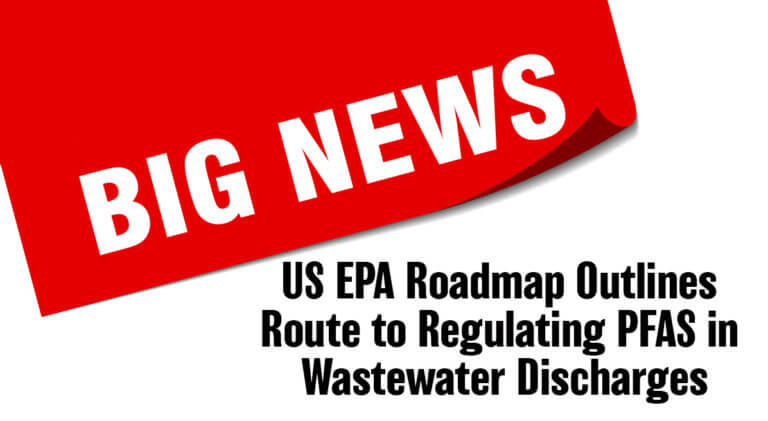
Big News! US EPA Roadmap Outlines Route to Regulating PFAS in Wastewater Discharges
In a news release dated April 28, 2022, US EPA outlined several steps the agency is taking that will bring it closer to regulating per- and polyfluoroalkyl substances (PFAS) in wastewater discharges, including proposing health-based aquatic life criteria for two well-known PFAS, outlining how PFAS monitoring should be included in US EPA-issued permits, and proposing a screening method for thousands of PFAS. “EPA is using all available tools to address PFAS contamination as part of a broader, whole of government effort to protect communities across the country from these chemicals,” said US EPA Administrator Michael S. Regan.
US EPA outlined plans to develop the aquatic life criteria in its PFAS roadmap, which says final aquatic life criteria are expected in “winter 2022” and states “use EPA-recommended water quality criteria to develop water quality standards to protect and restore waters, issue permits to control PFAS discharges, and assess the cumulative impact of PFAS pollution on local communities,” the roadmap says. The perfluorooctanoic acid (PFOA) and perfluorooctane sulfonic acid (PFOS) criteria are intended to protect aquatic life in the United States from short-term and long-term toxic effects. Following the comment period, US EPA intends to issue final PFOA and PFOS recommended criteria, considering public comments and any new toxicity data. States and Tribes may consider adopting the final criteria into their water quality standards or can adopt other scientifically defensible criteria that are based on local or site-specific conditions.
The proposed criteria have both acute and chronic values for the water column as well as tissue concentrations for invertebrate whole body, fish whole body and fish muscle, with different values for PFOA and PFOS. For example, the acute water column value for PFOA is 49 milligrams per liter (mg/L) while the chronic value is 0.094 mg/L. The invertebrate value is 1.11 milligrams per kilograms wet weight (mg/kg ww), the fish whole body value is 6.10 mg/kg ww, and the fish muscle value is 0.125 mg/kg ww. The acute water column value for PFOS is 3.0 mg/L and the chronic value is 0.0084 mg/L. The invertebrate value is 0.937 mg/kg ww, the fish whole body value is 6.75 mg/kg ww, and the fish muscle value is 2.91 mg/kg ww.
Once published in the Federal Register, US EPA will take comment for 30 days on the draft PFOA criteria and the draft PFOS criteria, and then prepare a response to comments document, update the draft criteria documents and consider new toxicity data published since September 2021 prior to issuing final recommended criteria, a US EPA fact sheet says.
NPDES Permits
On April 28, 2022, US EPA had also issued a memorandum to its regional water division directors titled Addressing PFAS Discharges in EPA-Issued NPDES Permits and Expectations Where EPA is the Pretreatment Control Authority, which the agency says aligns EPA-issued wastewater and stormwater discharge permits under the National Pollutant Discharge Elimination System (NPDES) and pretreatment program with the goals articulated in the PFAS Roadmap. These include enhanced monitoring provisions, use of new analytical methods, and implementation of pollution prevention and best management practices (BMPs) to address PFAS discharges at the source. The April 28 memorandum supplants a November 2020 memo that outlined an interim strategy for PFAS in NPDES permits and called for phased-in monitoring of and BMPs for PFAS in wastewater and stormwater permits.
The memorandum applies directly only to the three states where US EPA is the permitting authority (Massachusetts, New Hampshire and New Mexico — as well as the District of Columbia and most U.S. territories), although states could choose to adopt similar approaches. “While the Office of Water works to revise [effluent limitations guidelines (ELGs)] and develop water quality criteria to support technology-based and water quality-based effluent limits for PFAS in NPDES permits, this memorandum describes steps permit writers can implement under existing authorities to reduce the discharge of PFAS,” the memorandum says.
US EPA last year said it intends to revise ELGs for the Organic Chemicals, Plastics, and Synthetic Fibers (OCPSF) category and for the Metal Finishing category to address PFAS, and that the agency is studying other industrial sectors for possible PFAS ELGs, including landfills, manufacturers of textiles and carpets, leather tanning and finishing, paint formulating, electrical and electronic components, and plastics molding and forming. For industrial categories known or suspected to discharge PFAS, NPDES permits should require effluent monitoring, using draft analytical method 1633; BMPs for PFAS, including product substitution, reduction, or elimination for discharges with PFAS as detected by Method 1633; and BMPs to address PFAS-containing firefighting foams for stormwater permits.
For publicly owned treatment works (POTWs), the memo calls for the use of Method 1633 to monitor at least quarterly for PFAS in effluent, influent and biosolids. And where US EPA is the pretreatment authority, permits for POTWs should contain permit requirements to identify and locate all possible industrial users that may be subject to the pretreatment and require BMPs and pollution prevention to address PFAS discharges to POTWs. The memorandum also calls on NPDES permit writers to collaborate with their drinking water program counterparts to determine when public water systems that are located downstream from PFAS dischargers should be notified.
Analytical Method
Lastly, US EPA has published draft analytical Method 1621, “Screening Method for the Determination of Adsorbable Organic Fluorine (AOF) in Aqueous Matrices by Combustion Ion Chromatography (CIC),” a single-laboratory validated method to screen for organofluorines in wastewater. Organofluorines are molecules with a carbon-fluorine bond, and the most common source of organofluorines are PFAS and non-PFAS fluorinated compounds such as pesticides and pharmaceuticals, US EPA says. “The method is labeled as a screening method because it does not quantify all organofluorines with the same accuracy and has some known interferences that are discussed in the first section of the method,” US EPA says on its website. “The method tells the user that the organofluorines are present, but does not identify which organofluorines are present. The strength of the method is that it can broadly screen for thousands of known PFAS compounds at the part per billion level in aqueous (water) samples.”
Draft Method 1621 has completed single-laboratory validation, and multi-laboratory validation will take place this summer. The April 28 NPDES memorandum says draft Method 1621 can be used in conjunction with draft Method 1633, if appropriate, when monitoring at POTWs.

